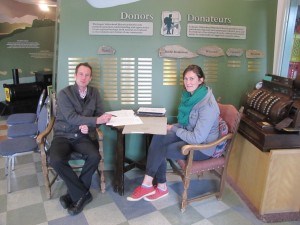
In 2016, a bronze sculpture will be erected in the garden outside the Jasper-Yellowhead Museum and Archives in commemoration of the Aseniwuche Winewak people who once called Jasper home.
The Aseniwuche Winewak, or Rocky Mountain People, currently reside in the Grande Cache area, however more than a century ago, they lived in Jasper, hunting, gathering and homesteading in what is now the park.
That all changed in 1907 when the federal goverment decided to establish the park, evicting the Aseniwuche Winewak, as well as other Aboriginal groups that frequented the park, because their traditional way of life was no longer permitted on protected land.
The sculpture, as well as a permanent exhibit inside the museum, will highlight the contribution of the Aseniwuche Winewak people to the region and commemorate their traditional way of life within the park.
“There was a very important Aboriginal presence and connection to Jasper National Park and it belongs in the museum,” said Andy Klimach, manager of the museum. “I think we’ve been overdue in showcasing that and really showing people that aspect of our history.”
Klimach has been collaborating on the project with Parks Canada’s Aboriginal liaisons and the Aseniwuche Winewak Nation of Canada (AWN) since July 2014.
He said he’s extremely proud of what they’ve been able to achieve.
“I think it’s really important for groups to collaborate, work together and listen to each other to make good things happen and I’m really pleased to have worked with Parks and the AWN in making this a reality.”
The four-foot bronze sculpture, which is expected to be completed in time for National Aboriginal Day in June, will depict an elder gathering berries and herbs and is entitled Kokum, the Cree word for grandmother.
Alberta artist Crystal C. Mossing, who is best known for her sculptures for the Calgary Stampede, has been commissioned to create the piece.
Rachelle MacDonald of the AWN did not return phone calls before press time, but in a press release, David McPhee, president of the AWN, said the sculpture “is a step forward in reconciliation; recognition of the people and history of the area.
“This represents an acknowledgement of the people who lived here and an honouring of that is symbolized in this statue,” he said.
As well as the sculpture, the permanent display case will also be completed by the spring, showcasing the traditional food of the Aseniwuche Winewak community, as well as production techniques used by their elders.
Through these new displays, Klimach said visitors to the museum will learn about and see the authentic connection of the Aseniwuche Winewak to the Jasper area.
Parks has spent the last decade working toward reconciliation with the Aseniwuche Winewak Nation, as well as the numerous other Aboriginal groups with connections to the area, and this collaborative project is another step in rebuilding that trust.
The agency’s efforts began with the creation of the Jasper Aboriginal Forum in 2006.
The forum was established to encourage healthy dialogue and working relationships between Parks and the Aboriginal groups with documented ties to the park.
Since the forum's creation, Parks has entered into formal agreements with some groups to allow traditional collection of medicinal plants growing within the park and it has designated a piece of land along the Maligne River — between Fifth Bridge and Sixth Bridge —as a cultural area for the groups that participate in the forum. The cultural site opened in 2013.
A representative from Parks’ Aboriginal liaison office was unavailable for comment for this story.
Nicole Veerman
[email protected]
